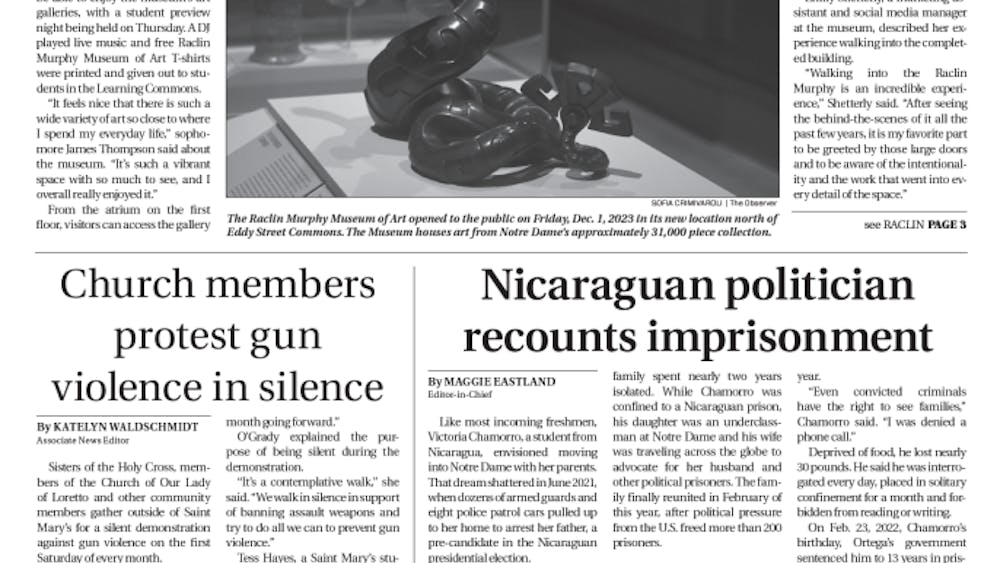There it sits, in the middle of campus. It looks innocent, quiet. But they say terrible things happened there. They say if you stay there long enough, you might start hearing things ... seeing things. Officially, it closes after 11 p.m. After all, would you want to be in there at midnight?
Every town has its haunted house. Notre Dame has Washington Hall.
Dedicated in 1882, Washington Hall was Notre Dame's main performing arts center from its dedication until the completion of the DeBartolo Performing Arts Center two years ago.
The ghost stories began in 1920, said Film, Television and Theatre professor Mark Pilkinton, who worked in the hall from 1984 to 2004 and is currently putting the finishing touches on a book entitled "The Story of Washington Hall: 1862-2004." Around Christmas of 1920, people began to report ghostly sounds in Washington Hall.
At the time, eight students living in the hall were startled by sounds of a French horn. They couldn't find its source, and they couldn't logically explain it.
A common misconception of the hall's ghost stories, Pilkinton said, is that they originated with Irish football legend George Gipp. Actually, it took five years for anyone to make a connection between the unsettling tales and Notre Dame's first football All-American, who, coincidentally, died in December 1920 - just before the stories began.
"The Gipper" did not live in Washington Hall, but he would supposedly sneak into the building when he missed curfew at his dormitory.
The legend says Gipp fell asleep outside Washington Hall and contracted the pneumonia that led to his death.
During the 1925-26 academic year, Pio Montenegro, a student from Brazil, was the first person to ever announce seeing a ghost at Washington Hall. Pilkinton said Montenegro lived in the Science Hall, now the LaFortune Student Center, and claimed to see something odd on the hall's south steps - which had been outside the building going up to the second floor.
Montenegro said he saw the ghost of George Gipp on a white horse galloping up the stairs and through the entrance. The story of Gipp haunting the hall has stuck ever since.
Montenegro was a popular student, Pilkinton said, and his story would have had credibility, though virtually no ghost sightings since then have been outside the building.
"Other people that have seen things, it's always been inside the building," Pilkinton said.
Strange stories surrounding the hall date back to even before 1920. In 1886, a steeplejack fell through Washington Hall's ceiling and died, though Pilkinton said evidence for the story is lacking.
The 1920-21 story, though well documented, may very well have had natural explanations. Joseph Casasanta, who wrote the Alma Mater and went on to become the director of the Notre Dame Marching Band for 20 years, lived in Washington Hall that year, and may have been the mysterious horn blower.
"If it were a hoax then he certainly might be involved, but we don't know," Pilkinton said. "People of faith who believe in ghosts like to believe in them and they like to connect it to George Gipp."
While the early stories are somewhat uncertain, the hall is not free from ghost tales.
"That's 86 years that there's been talk of this going on," Pilkinton said. "As a building, [Washington Hall] has a pretty long and continuing tradition that hasn't really gone away.
"It's been layered. Over the years there are additional stories, additional layers, permutations and combinations."
Other stories include groups of students sleeping in Washington Hall - some of whom had very strange experiences.
According to the hall's Web site, a group of students snuck in with a Ouija board to try to contact Gipp. The board spelled out "S ... G" then slide to "Goodbye." They tried again and had the same result: "S ... G" then "Goodbye." The students then exited the hall, but they were not alone. Bursting through the door of Washington Hall came a security guard (SG) who had just finished an inspection.
Washington Hall employees were reluctant to grant interviews regarding the ghost stories, partially because of the amount of ghost-related attention the hall has received from the media and even ghost hunters.
In 2004, a television crew for The Travel Channel came to Notre Dame to film a segment on Washington Hall for a program titled "Haunted Campuses," which aired in October of that year.
Pilkinton said the building still has the power to scare people.
"I don't think I'd want to be doing much in there all by myself ... those old buildings can be really spooky," he said. "It has all the things that a spooky place needs."
Though Pilkinton said other buildings on campus can be scary - and may even have a few horror stories of their own - there is only one building on campus consistently recognized for supernatural associations.
"Although there have been stories connected to other buildings on campus ... people always say Washington Hall, although it may simply be the poster child," he said. "Who's to say what's there and what's not?"
Christopher Sieving, a professor in the Film, Television and Theatre Department who teaches a class on horror films, said the Washington Hall stories do not seem to qualify as horrific.
Sieving referred to the story of Charles Whitman as a true horror tale. In 1966, Whitman climbed the 27-story tower at the University of Texas, then shot and killed 15 people and wounded 31 others.
"There are certainly ghost stories that have a real eerie component to them or involve some sort of violent death," Sieving said. "There's not a real strong sort of horror component [with Washington Hall]."
Tonight at 8 p.m. there will be a screening of "The Ring" in Washington Hall. Screams heard in the hall will be from the movie. After all, it's just an old, innocent building, right?






